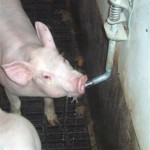A recently published paper by Bernardo Predicala and John Patience of the Prairie Swine Centre, describes a study that was conducted to determine if high levels of sulphate in the drinking water results in an increase in odour and gaseous emissions from the barn or affects other swine manure properties.
Introduction
Sulphur intake is of particular concern because out of the 10 most odorous components of swine odour identified so far, six were found to contain sulphur. These odour components are produced mainly from anaerobic breakdown of unutilized nutrients excreted by pigs into the manure.
Drinking water can contribute significantly to sulphur intake of pigs. One major source is the sulphate content in water supplies, which has been found to exceed 1600 mg/L in certain geographic areas. Studies showed that pigs offered water with increased sulphate levels (up to 1800 mg/L) had increased prevalence of non-pathogenic diarrhea, although growth performance was rarely impaired. However, no one has assessed the impact of poor water quality on air emissions and swine manure properties.
The overall goal of this study was to determine the effect of varying levels of sulphur in drinking water on odour and gaseous emissions and on manure nutrient composition. Pig growth performance was also measured. Four water treatments were compared, normal water, with a low sulphate content and water with 600, 1200 and 1800 milligrams per litre of sulphate. The waters containing elevated sulphate were formulated to reflect the composition of water observed on commercial farms experiencing high mineral levels in their drinking water.
The 2-ft deep manure pits in the rooms used for the trial were emptied every two weeks. To evaluate the effect of the treatments on manure properties and gaseous emissions from manure under long-term storage, manure samples were collected from each room just before emptying the pits. The manure sample was transferred into a 205L (45 gallon) barrel, one for each room, and stored for an additional five weeks to simulate longer-term manure storage.
Gas levels spike when pits pulled
The levels of ammonia (NH3) and carbon dioxide (CO2) in each room were monitored continuously but were not markedly different between the different treatments. There was no statistically significant impact of the sulphate levels in the water on the concentrations and emissions of these gases from the treatment rooms.
Monitoring of hydrogen sulphide (H2S) levels in each room showed that they were extremely low, less than one part per million, which was less than the minimum that the detection equipment could measure. However, when the manure pit-plug was pulled to clear the manure from the pits, H2S levels increased during the approximately 15-min period in which the manure slurry was flowing out of the pit. A typical plot of the H2S levels during the plug-pulling day is shown in Figure 1; a similar pattern was observed in all of the rooms.
The peak H2S levels in the treatment rooms that received high-sulphate water (1200 and 1800 ppm) tended to be higher than in the low-sulphate rooms (Control and 600 ppm). However, these spikes occurred for only a short period of time and the high levels (288 and 134 ppm H2S for 1200 and 1800 ppm sulphate respectively) were dissipated to less than 10 ppm in less than 10 minutes. Nevertheless, it is possible that high-sulphate levels in drinking water could contribute to the generation of high H2S levels during manure clearing operations. If not conducted properly, this could potentially lead to exposure of barn workers and pigs to elevated H2S levels.
Odour and emissions not affected
Odour concentration and emissions were not affected by the water treatment and high sulphate levels did not lead to an increase in the measurements of these parameters.
Analysis of manure samples collected from the manure pit of each room and from the barrels used to simulate longer-term manure storage showed no significant effect of water treatment on total nitrogen, ammonia-N, total solids or phosphorus in the room manure samples, but there were significant effects on potassium and sulphur levels. As would be expected, the manure sulphur level increased as water sulphate level increased.
Interestingly, comparison of nutrient levels in the barrel manure samples showed significant differences between treatments for all nutrients tested. Manure samples from the treatment rooms with sulphate added to the drinking water tended to have about 10% higher nutrient levels relative to the control samples (excluding S and Na which had 50% more than the control due to the treatment). Thus, it would appear that high-sulphate drinking water may result in better retention of nutrients in stored manure.
Pig performance was not adversely affected by high levels of sulphate in the pig’s drinking water. During the study, no notable incidence of scouring or diarrhea was observed. The pigs’ average daily gain ranged between 0.86 to 1.12 kg/day but was not different between treatments.
Conclusions
Elevated levels of sulphate in the drinking water had no adverse impact on manure nutrient composition, odour and gas (NH3 and CO2) emissions or on the performance of grower-finisher pigs. Thus, water containing up to 1600 to 1800 ppm sulphate can be used for growing and finishing pigs with no concern for animal performance or for odour or gas emissions from the barn. However, we suggest one caution. When using high-sulphate drinking water, the potential exists for higher H2S spikes during manure handling operations. Appropriate measures should be taken to protect animal and worker health and safety. While water quality may impact other aspects of barn siting, growout pig performance and odour and gas emissions should not be a concern.
Photo caption: Figure 1: Typical H2S levels monitored in a treatment room, showing no detectable values throughout most of the day, except during the plug-pulling event (indicated by the spike in H2S levels)










